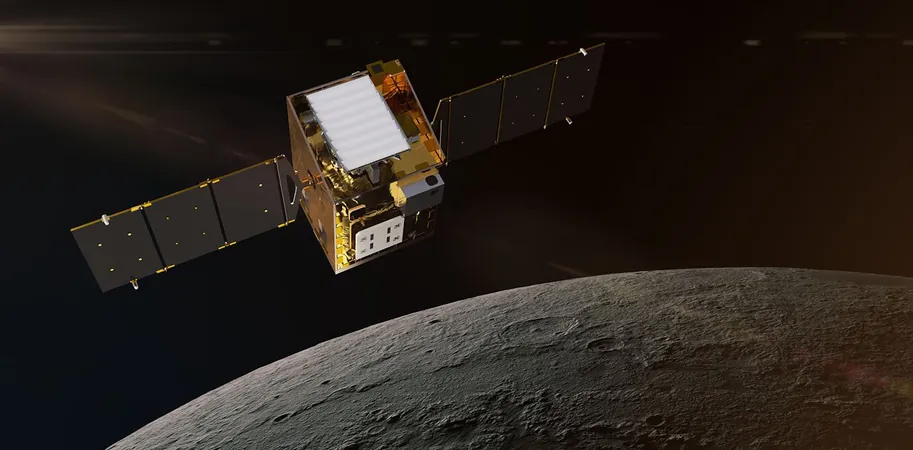
NASA's Lunar Trailblazer: Pioneering Discoveries Await from the Moon in 2025
2024-12-31
Author: Daniel
NASA's Artemis II Mission
As humanity prepares for its next grand lunar venture, NASA's Artemis II mission, aimed at returning astronauts to the Moon, is set for no earlier than April 2026. This will mark the first human touch on the lunar surface since the Apollo 17 mission in 1972. However, before astronauts embark on this remarkable journey, two vital missions will take place to explore the Moon's south pole, seeking resources that could potentially support human life and enhance scientific knowledge.
Exploring the Moon's Potential with PRIME-1 and Lunar Trailblazer
One of these missions is Lunar Trailblazer, a groundbreaking satellite designed to revolutionize our understanding of the Moon's surface and the critical element of water. Planetary scientists are eager to utilize the data from this innovative micro-mission, as it will provide insights into how water forms and operates on rocky celestial bodies.
Scheduled for launch in January 2025, PRIME-1 (Polar Resources Ice Mining Experiment) aims to assess lunar soil for potential water and ice deposits. Mounted on its lander, the mission will leverage advanced tools including the Regolith and Ice Drill for Exploring New Terrain (TRIDENT) that will excavate soil up to three feet deep, and the Mass Spectrometer for Observing Lunar Operations (MSOLO), which will analyze the extracted samples to determine their composition, including water content.
Simultaneously, Lunar Trailblazer will be launched aboard the same Falcon 9 rocket, making it a cost-efficient multi-mission operation. The principal investigator, Bethany Ehlmann, leads a dedicated team from Caltech, focusing on practical operational experience at a fraction of the budget compared to traditional missions. Although Lunar Trailblazer has slightly exceeded its $55 million budget cap, at $80 million, it still remains significantly lower than typical NASA robotic missions.
The Era of Small Satellites: A Game Changer for Space Exploration
The development of small satellites, or SmallSats, has been pivotal in making missions like Lunar Trailblazer feasible. Equipped with high-precision instruments and commercial off-the-shelf components, SmallSats enable scientists to gather specific data that can elucidate complex questions about the Moon's geology and composition.
For instance, Lunar Trailblazer will function alongside other small missions to provide a comprehensive, high-resolution view of the Moon, illustrating the interaction of sunlight and shadow with the lunar surface. This method not only enhances measurement accuracy but also allows scientists to conduct high-risk research without the monumental financial constraints that often accompany larger missions.
Unraveling the Mystery of Lunar Water
The Moon's surface has intrigued scientists for centuries, but it was only with NASA's 1990s Clementine mission that concrete evidence of water was detected. This initial discovery sparked numerous subsequent missions, including the Lunar Prospector and the Lunar Reconnaissance Orbiter, revealing water-ice deposits in permanently shaded regions of the Moon.
With Lunar Trailblazer, researchers will examine the state of water on the Moon in unprecedented detail. It is equipped with the Lunar Thermal Mapper (LTM) to monitor surface temperatures and the High-resolution Volatiles and Minerals Moon Mapper (HVM3) to analyze how lunar rocks reflect light, helping to identify water in both liquid and ice forms.
Setting the Stage for Future Lunar Missions
Understanding the behavior of water on the Moon is not just an academic pursuit; it has significant implications for future lunar missions and human presence on the Moon. Scientists hypothesize that the water present on the Moon could either be remnants from its formation, a byproduct of asteroidal impacts, or generated through solar wind interactions. Lunar Trailblazer aims to clarify these origins and may reveal essential lessons about water's role in the solar system.
This mission promises to shed light on critical questions regarding lunar exploration, paving the way for sustainable human habitation on the Moon. As we stand on the brink of a new era in space exploration, the findings from Lunar Trailblazer could lead to groundbreaking discoveries about our celestial neighbor and beyond.
Stay tuned as NASA continues to unveil the mysteries of our universe, one mission at a time!
 Brasil (PT)
Brasil (PT)
 Canada (EN)
Canada (EN)
 Chile (ES)
Chile (ES)
 Česko (CS)
Česko (CS)
 대한민국 (KO)
대한민국 (KO)
 España (ES)
España (ES)
 France (FR)
France (FR)
 Hong Kong (EN)
Hong Kong (EN)
 Italia (IT)
Italia (IT)
 日本 (JA)
日本 (JA)
 Magyarország (HU)
Magyarország (HU)
 Norge (NO)
Norge (NO)
 Polska (PL)
Polska (PL)
 Schweiz (DE)
Schweiz (DE)
 Singapore (EN)
Singapore (EN)
 Sverige (SV)
Sverige (SV)
 Suomi (FI)
Suomi (FI)
 Türkiye (TR)
Türkiye (TR)
 الإمارات العربية المتحدة (AR)
الإمارات العربية المتحدة (AR)